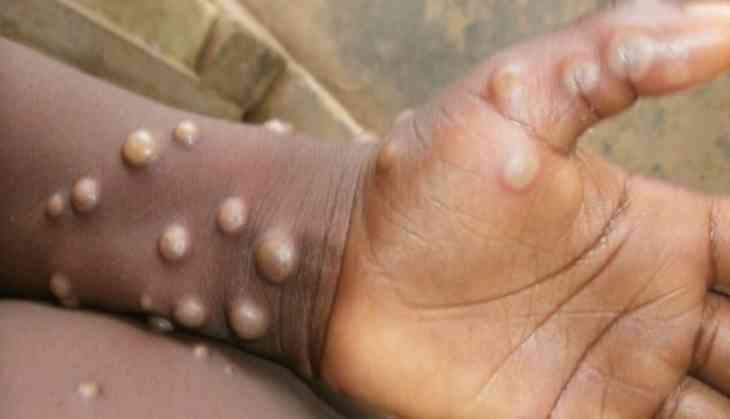
In the wake of the rising cases of Monkeypox in the country, Union Health Ministry on Wednesday released guidelines to prevent the spread of Monkeypox disease.
The Ministry, in its official communication, informed that there was no reported case of the Monkeypox virus in India till May 31, 2022. However, India needs to be prepared in view of the increasing reports of cases in non-endemic countries.
What is Monkeypox?
Monkeypox (MPX) is a viral zoonotic disease with symptoms similar to smallpox, although with less clinical severity. MPX was first discovered in 1958 in colonies of monkeys kept for research, hence the name 'Monkeypox.'
The first human case of Monkeypox was reported in the Democratic Republic of the Congo (DRC) in 1970. The Monkeypox Virus primarily occurs in Central and West Africa. In 2003, the first Monkeypox outbreak outside of Africa was reported in the United States of America, which was linked to contact with infected pet prairie dogs. These pets had been housed with Gambian pouched rats and dormice that had been imported into the country from Ghana.
Monkeypox is usually a self-limited disease with symptoms lasting from 2 to 4 weeks. Severe cases occur more commonly among children and are related to the extent of virus exposure, patient health status and nature of complications.
Mode of Transmission
Human-to-human transmission is known to occur primarily through large respiratory droplets generally requiring prolonged close contact. It can also be transmitted through direct contact with body fluids or lesion material, and indirect contact with lesion material, such as through contaminated clothing or linens of an infected person.
Animal-to-human transmission may occur by a bite or scratch of infected animals like small mammals including rodents (rats, squirrels) and non-human primates (monkeys, apes) or through bush meat preparation.
Suspected case
A person of any age having history of travel to affected countries within the last 21 days presenting with an unexplained acute rash and one or more of the following signs or symptoms.
Swollen lymph nodes
Fever
Headache
Body aches
profound weakness
Common symptoms and signs
Prodrome (0-5 days)
a. Fever
b. Lymphadenopathy
Typically occurs with fever onset
Periauricular, axillary, cervical or inguinal
Unilateral or bilateralc. Headache, muscle aches, exhaustion
d. Chills and/or sweats
e. Sore throat and cough
Skin involvement (rash)
a. Usually begins within 1-3 days of fever onset, lasting for around 2-4 weeks
b. Deep-seated, well-circumscribed and often develop umbilication
c. Lesions are often described as painful until the healing phase when they become itchy (in the crust stage)
The Ministry further laid down guidelines for proper monitoring of those who came in contact with the infected person.
a) Contacts should be monitored at least daily for the onset of signs/symptoms for a period of 21 days (as per case definition above) from the last contact with a patient or their contaminated materials during the infectious period. In case of occurrence of fever clinical/lab evaluation is warranted.
b) Asymptomatic contacts should not donate blood, cells, tissue, organs or semen while they are under surveillance.
c) Pre-school children may be excluded from day care, nursery, or other group settings.
d) Health workers who have unprotected exposures to patients with monkeypox or possibly contaminated materials do not need to be excluded from work duty if asymptomatic, but should undergo active surveillance for symptoms for 21 days.
Measures to prevent infection with monkeypox virus
1. Avoid contact with any materials, such as bedding, that has been in contact with a sick person.
2. Isolate infected patients from others.
3. Practice good hand hygiene after contact with infected animals or humans. For example, washing your hands with soap and water or using an alcohol-based hand sanitizer.
4. Use appropriate personal protective equipment (PPE) when caring for patients.
5. Surveillance and rapid identification of new cases is critical for outbreak containment. During human Monkeypox outbreaks, close contact with infected persons is the most significant risk factor for monkeypox virus infection. Health workers and household members are at a greater risk of infection.
6. Health workers caring for patients with suspected or confirmed monkeypox virus infection, or handling specimens from them, should implement standard infection control precautions. Samples taken from people and animals with suspected monkeypox virus infection should be handled by trained staff working in suitably equipped laboratories. Patient specimens must be safely prepared for transport with triple packaging in accordance with WHO guidance for transport of infectious substances.
Infection Prevention and Control (IPC)
A combination of standard, contact, and droplet precautions should be applied in all healthcare settings when a patient presents with fever and vesicular/pustular rash. In addition, because of the theoretical risk of airborne transmission of Monkeypox virus, airborne precautions should be applied as per risk assessment.
In the wake of the rising cases of Monkeypox in the country, Union Health Minister Mansukh Mandaviya on Tuesday assured citizens not to panic and said that an awareness campaign is being run in collaboration with the state governments to prevent the spread of the infection.
Speaking in Rajya Sabha on Tuesday during the ongoing Monsoon session of the Parliament, the Union Minister said, "There is no need to be afraid of Monkeypox, an awareness campaign is being run in collaboration with the state governments: Public awareness is very necessary in the context of Monkeypox. We have also formed a task force under the chairmanship of a member of NITI Aayog on behalf of the Government of India."
"On the basis of the observations of the task force, we will assess and study the further action to be taken. If the state government of Kerala needs any kind of help from the Central government, it will be given. Also, an expert team of the Central government is guiding the state government from time to time," he said.
(ANI)
Also Read: Study reveals connection between heart disease and soil contamination


